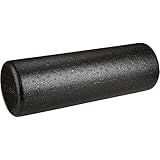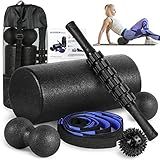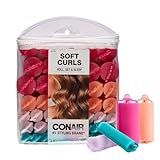Best Foam Rollers to Buy in December 2025

Amazon Basics High Density Foam Roller for Exercise and Recovery, 18 Inches, Black
- DURABLE POLYPROPYLENE FOAM ROLLER FOR LASTING PERFORMANCE AND COMFORT.
- LIGHTWEIGHT DESIGN FOR EASY TRANSPORT AND REPOSITIONING DURING WORKOUTS.
- PERFECT FOR BALANCE, STRENGTH, AND FLEXIBILITY EXERCISES AT ANY LEVEL.



Amazon Basics High Density Foam Roller for Exercise and Recovery, 24 Inches, Blue Speckled
- IDEAL FOR BALANCE AND FLEXIBILITY WORKOUTS; PERFECT FOR ALL FITNESS LEVELS.
- DURABLE, SHAPE-RETAINING FOAM WITH MOLDED EDGES FOR ADDED COMFORT.
- LIGHTWEIGHT, PORTABLE DESIGN; EASY TO CLEAN FOR HASSLE-FREE USE.



TriggerPoint Grid 1.0 Foam Roller - 13" Multi-Density Massage Roller for Deep Tissue & Muscle Recovery - Relieves Tight, Sore Muscles & Kinks, Improves Mobility & Circulation - Targets Key Body Parts
- BOOST RECOVERY WITH OUR MULTI-DENSITY GRID FOR OPTIMAL MUSCLE RELIEF.
- EXPERIENCE COMFORT WITH UNIQUE FOAM & DISTRODENSITY ZONES FOR ALL MUSCLES.
- ACHIEVE DEEP TISSUE RELIEF WITH FIRM, DURABLE EVA-FOAM DESIGN.



Foam Roller Set - High Density Back Roller, Muscle Roller Stick,2 Foot Fasciitis Ball, Stretching Strap, Massager Ball for Whole Body Physical Therapy & Exercise, Yoga, Back Pain, Leg, Deep Tissue
- BOOST RECOVERY: RELIEVE SORENESS AND ENHANCE PERFORMANCE PRE/POST-WORKOUT.
- DURABLE DESIGN: HIGH-DENSITY FOAM SUPPORTS 300 LBS; SILENT, SHAPE-RETAINING.
- PORTABLE CONVENIENCE: COMES WITH A NYLON BAG; TAKE YOUR WELLNESS ANYWHERE.



Conair Foam Hair Rollers - 48 Count, Assorted Colors - Heatless Curls, Overnight Curls, Foam Rollers with Storage Case
-
COMFORTABLE OVERNIGHT CURLS: ENJOY BEAUTIFUL CURLS WHILE YOU SLEEP!
-
VERSATILE SIZES FOR EVERY STYLE: CHOOSE CURL SIZE FOR DEFINED OR VOLUMINOUS LOOKS.
-
SUITABLE FOR ALL HAIR TYPES: EASY, HEATLESS STYLING PERFECT FOR FINE HAIR!



ProsourceFit High Density Foam Rollers 12 - inches long, Firm Full Body Athletic Massage Tool for Back Stretching, Yoga, Pilates, Post Workout Muscle Recuperation, Black
- HIGH-DENSITY FOAM FOR DEEP MUSCLE RELIEF-PERFECT FOR ALL FITNESS LEVELS.
- VERSATILE TOOL FOR PRE/POST-WORKOUT RECOVERY AND MUSCLE MOBILITY.
- CHOOSE FROM 4 SIZES FOR OPTIMAL COMFORT, TRAVEL, AND SPACE-SAVING!



Yes4All High-Density EPP Round Back Roller Foam, Exercise Foam Roller for Yoga, & Pilates, Multiple Sizes & Colors - Black, 36 inches
- ENHANCES RECOVERY FOR DIVERSE ACTIVITIES: YOGA, BODYBUILDING, AND MORE.
- HIGH-DENSITY DESIGN ENSURES FIRM SUPPORT FOR PROFESSIONAL USE.
- MULTIPLE SIZES FOR TARGETED THERAPY OR FULL-BODY RECOVERY NEEDS.


When it comes to enhancing your physical fitness routine or aiding in muscle recovery, the foam roller is an essential tool to consider. It is a versatile, affordable, and effective tool that has become increasingly popular among athletes, physical therapists, and fitness enthusiasts alike. Whether you're a beginner or a seasoned pro, understanding how to choose the best foam roller can greatly enhance your experience and outcomes.
Understanding Foam Rollers
Foam rollers are cylindrical pieces of compressible foam often used for self-myofascial release, a technique that helps release muscle tightness and improve mobility. They are commonly used to alleviate muscle soreness, improve flexibility, and prevent injuries. Regular use of a foam roller can help accelerate recovery, increase blood flow, and reduce the risk of injuries by promoting better muscle function and flexibility.
Types of Foam Rollers
Understanding the different types of foam rollers is the first step in selecting the best one for your needs.
1. Standard Density Foam Rollers
Standard density foam rollers are generally medium-firm and are suitable for beginners who are new to foam rolling. They offer a balanced mix of firmness and cushioning, which makes them ideal for general use.
2. High-Density Foam Rollers
High-density foam rollers are firmer and provide a deeper massage. They are well-suited for more advanced users or those with a higher tolerance for pressure. These rollers are more durable and can withstand more intense and frequent use.
3. Textured Foam Rollers
Textured foam rollers come with ridges, bumps, or grids, designed to target specific muscle knots and provide a more varied massage. They can penetrate deeper into the muscles, making them a good choice for experienced users who need targeted release.
4. Soft Foam Rollers
Soft foam rollers are less dense and provide a gentler massage, suitable for individuals new to foam rolling, seniors, or those with particularly sensitive muscles. They offer a more comfortable experience and are often used for therapeutic purposes.
5. Vibrating Foam Rollers
Vibrating foam rollers add vibration technology to the mix, providing a more intense massage that can enhance muscle relaxation and blood flow. They are typically more expensive but can be particularly beneficial for advanced users seeking enhanced recovery benefits.
How to Choose the Best Foam Roller
With so many options available, selecting the best foam roller can be a daunting task. Here are some factors to consider when making your decision:
1. Assess Your Experience Level
Consider your familiarity with foam rolling. If you're a beginner, opting for a standard or soft foam roller could provide the ideal starting point. Conversely, if you have extensive experience, you might benefit from a high-density or textured roller.
2. Identify Your Needs and Goals
Think about what you hope to achieve with your foam roller. If your goal is to improve overall flexibility or aid general muscle recovery, a standard roller might suffice. However, if you need to target specific muscle groups or alleviate deep-seated knots, a textured roller may be more appropriate.
3. Consider the Material and Firmness
The material and firmness of the foam roller are crucial considerations. High-density foam is more durable and offers greater firmness, while low-density options provide a softer feel. Determine the appropriate balance for your comfort and therapeutic goals.
4. Evaluate the Portability
If you need a roller to carry to the gym or take with you while traveling, consider the size and weight. Compact, lightweight rollers, or those designed with portability in mind, can be more convenient for on-the-go use.
5. Think About Additional Features
Additional features, such as vibration, may offer enhanced benefits but come at a higher cost. Evaluate whether these features align with your needs and whether they are worth the investment.
Conclusion
Foam rollers are invaluable tools for anyone looking to improve muscle recovery, enhance flexibility, and prevent injuries. By understanding the different types of foam rollers and evaluating your personal needs and fitness goals, you can select the perfect foam roller to elevate your fitness regimen. Incorporating foam rolling into your routine can lead to significant improvements in your physical health and overall well-being.
